|
|
Arthropods - Crustacean |
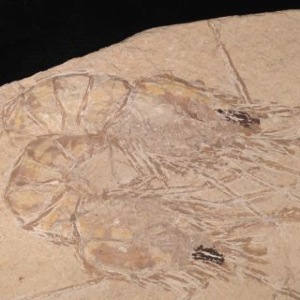 Crustacea are mainly aquatic, carnivorous arthropods, whose body and legs are enclosed by a supporting chitinous shell. The body is divisible into head and thorax may fuse together in a cephalothorax. The head has two pairs of tactile antennae, and three pairs of limbs with food handling abilities. The walking legs are divided in two, and may have gills for breathing. The last abdominal appendage may become flattened, to form a tail fan with the end spine. Crustacea are mainly aquatic, carnivorous arthropods, whose body and legs are enclosed by a supporting chitinous shell. The body is divisible into head and thorax may fuse together in a cephalothorax. The head has two pairs of tactile antennae, and three pairs of limbs with food handling abilities. The walking legs are divided in two, and may have gills for breathing. The last abdominal appendage may become flattened, to form a tail fan with the end spine.
|
|
Arthropods - Trilobites |
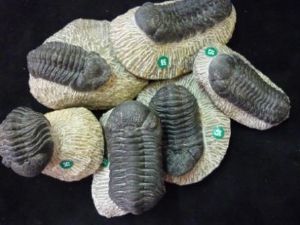 Trilobites (meaning "three lobes") are a well-known fossil group of extinct marine Arthropods that form the class Trilobita. Trilobites form one of the earliest known groups of Arthropods. The first appearance of Trilobites in the fossil record defines the base of the Atdabanian stage of the Early Cambrian period (521 Million Years ago), and they flourished throughout the lower Palaeozoic era before beginning a drawn-out decline to extinction when, during the Devonian, all trilobite orders except Proetida died out. Trilobites finally disappeared in the mass extinction at the end of the Permian about 250 Million Years ago. The Trilobites were among the most successful of all early animals, roaming the oceans for over 270 million years. Trilobites (meaning "three lobes") are a well-known fossil group of extinct marine Arthropods that form the class Trilobita. Trilobites form one of the earliest known groups of Arthropods. The first appearance of Trilobites in the fossil record defines the base of the Atdabanian stage of the Early Cambrian period (521 Million Years ago), and they flourished throughout the lower Palaeozoic era before beginning a drawn-out decline to extinction when, during the Devonian, all trilobite orders except Proetida died out. Trilobites finally disappeared in the mass extinction at the end of the Permian about 250 Million Years ago. The Trilobites were among the most successful of all early animals, roaming the oceans for over 270 million years.
|
|
Cartilaginous - Sharks |
 Creatures of this class are characterised by a cartilaginous skeleton made up of tiny, calcified prisms. Living examples include the Sharks, Skates, and Rays. Cartilage is not usually preserved, so common fossils tend to be teeth, scales, and dorsal-fin spines. Sharks’ teeth are continuously replaced from behind, being shed from the jaw margin or lost during feeding. Chondrichthyans diversified from Devonian (period) origins to become very common in today’s sea. Creatures of this class are characterised by a cartilaginous skeleton made up of tiny, calcified prisms. Living examples include the Sharks, Skates, and Rays. Cartilage is not usually preserved, so common fossils tend to be teeth, scales, and dorsal-fin spines. Sharks’ teeth are continuously replaced from behind, being shed from the jaw margin or lost during feeding. Chondrichthyans diversified from Devonian (period) origins to become very common in today’s sea. |
|
Echinoderms - Starfish & Brittle Stars |
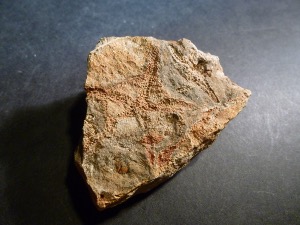
Starfish or sea stars are star-shaped Echinoderms belonging to the class Asteroidea. About 1,500 species of starfish occur on the seabed in all the world's oceans, from the tropics to frigid polar waters. They are found from the intertidal zone down to abyssal depths, 6,000 m (20,000 ft) below the surface.
Starfish are marine invertebrates. They typically have a central disc and five arms, though some species have more than this. The aboral or upper surface may be smooth, granular or spiny, and is covered with overlapping plates. Many species are brightly coloured in various shades of red or orange, while others are blue, grey or brown.
Brittle stars or ophiuroids are Echinoderms in the class Ophiuroidea closely related to the Starfish. They crawl across the sea floor using their flexible arms for locomotion. The ophiuroids generally have five long, slender, whip-like arms which may reach up to 60 cm (24 in) in length on the largest specimens.
The Ophiuroidea contain two large clades (family tree), Ophiurida (brittle stars) and Euryalida (basket stars). Many of the ophiuroids are rarely encountered in the relatively shallow depths normally visited by humans, but they are a diverse group. Over 2,000 species of brittle stars live today. More than 1200 of these species are found in deep waters, greater than 200 m deep.
|
|
Echinoderms - Crinoids |
 The Echinoderms include the Echinoids (Sea Urchins), Holothuroids (Sea Cucumber), Asteroids (Starfish ), Crinoids (Sea Lilies), as well as the extinct Blastoids, Cycstoids, and Carpoids. The Echinoderms include the Echinoids (Sea Urchins), Holothuroids (Sea Cucumber), Asteroids (Starfish ), Crinoids (Sea Lilies), as well as the extinct Blastoids, Cycstoids, and Carpoids.
Crinoids (Sea Lilies)
Crinoids, popularly known as sea lilies and feather stars, possess a massive calcite skeleton, and were so abundant in the Palaeozoic seas that their remains formed vast thicknesses of limestone. Most Crinoids are attached to sea bed by a flexible stem, circular or pentagonal in sections, and made up of numerous disc like plates called columnals. At the top of the stem is a swollen cup or calyx (head) to which the arms are attached. The arms are used to filter food from the water. Soon after death, the entire skeleton normally falls apart into the small, separate plates called ossicles. In contrast, well-preseved crinoids are rare and beautiful fossils. |
|
Echinoderms - Sea Urchins |
 The Echinoderms include the Echinoids (Sea Urchins), Holothuroids (Sea Cucumber), Asteroids (Starfish ), Crinoids (Sea Lilies), as well as the extinct Blastoids, Cycstoids, and Carpoids. The Echinoderms include the Echinoids (Sea Urchins), Holothuroids (Sea Cucumber), Asteroids (Starfish ), Crinoids (Sea Lilies), as well as the extinct Blastoids, Cycstoids, and Carpoids.
Echinoids (Sea Urchins)
The Echinoids possess a rigid, globular skeleton made up of columns of thin, calcite plates (ambulacrals and interambulacrals). The plates known as ambulacrals have small pores for tube feet. All plates have swollen tubercles for the ball-and-socket articulation of spines, which are used for defence and some-times for walking. Regular Echinoids, which forage on the sea bed show radial symmetry; irregular Echinoids, which usually burrow in soft sea beds, show bilateral symmetry.
|
|
|
Graptolites |
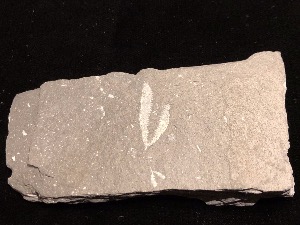
Graptolite fossils are extinct marine animal very early in evolution, very much like their contemporaries the Trilobites. |
|
Invertebrates - Corals & Sponges |
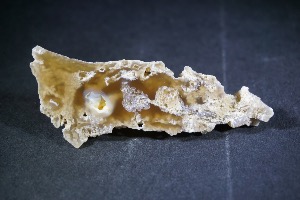
Corals are marine animals with a sac-like body (polyp), mouth, tentacles, and skeleton. They typically live in compact colonies of many identical individual polyps.
Although corals first appeared in the Cambrian period, some 542 million years ago, fossils are extremely rare until the Ordovician period, 100 million years later, when rugose and tabulate corals became widespread.
Sponges belong to a group know as Porifera (meaning "pore bearer”). They are a multi-celled organism with a sack like body which are supported by small internal spines called spicules.
|
|
Molluscs - Ammonites |
 Ammonites are a form of ammonoid distinguished by their complex suture lines. They were abundant and diverse in the seas of the Mesozoic Era, and they evolved very rapidly to produce a number of species and genera. After a decline in diversity during the late Cretaceous period, ammonites become extinct at the same time as other marine groups, such as Belemnites, and terrestrial groups, such as dinosaurs. Ammonites are a form of ammonoid distinguished by their complex suture lines. They were abundant and diverse in the seas of the Mesozoic Era, and they evolved very rapidly to produce a number of species and genera. After a decline in diversity during the late Cretaceous period, ammonites become extinct at the same time as other marine groups, such as Belemnites, and terrestrial groups, such as dinosaurs. |
|
Molluscs - Belemnites |
|
Belemnites are an extinct order of squid-like cephalopods that existed from the Late Triassic to Late Cretaceous. |
|
Molluscs - Bivalves |
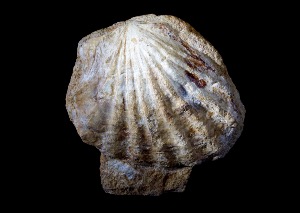 The Molluscs compose the large group of invertebrate animals known as the Mollusca. Around 85,000 extents species of Molluscs are recognised. The Molluscs compose the large group of invertebrate animals known as the Mollusca. Around 85,000 extents species of Molluscs are recognised.
Molluscs not just in size and in anatomical structure, but also in behaviour and in habitat too are a very diverse group that includes Chitons, Scaphopods, Bivalves, Gastropods and Cephalopods. The soft body is rarely preserved, so Molluscs are classified by their shell structure.
Bivalves:
Bivalves comprise a class of marine and freshwater molluscs that have laterally compressed bodies enclosed by a shell consisting of two hinged parts.
|
|
Molluscs - Gastropods |
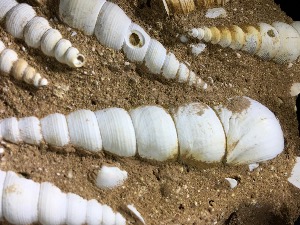 The Molluscs compose the large group of invertebrate animals known as the Mollusca. Around 85,000 extents species of Molluscs are recognised. The Molluscs compose the large group of invertebrate animals known as the Mollusca. Around 85,000 extents species of Molluscs are recognised.
Molluscs not just in size and in anatomical structure, but also in behaviour and in habitat too are a very diverse group that includes Chitons, Scaphopods, Bivalves, Gastropods and Cephalopods. The soft body is rarely preserved, so Molluscs are classified by their shell structure.
Gastropods:
Single, asymmetrical, spiral, un-chambered calcium-carbonte shell. |
|
Molluscs - Goniatites |
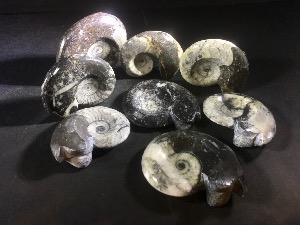 Goniatites lived in Carboniferous shelf sea, occurring locally in swarms of it's shell suggests that Goniatites was a poor swimmer. Goniatites lived in Carboniferous shelf sea, occurring locally in swarms of it's shell suggests that Goniatites was a poor swimmer. |
|
Molluscs - Nautiloids |
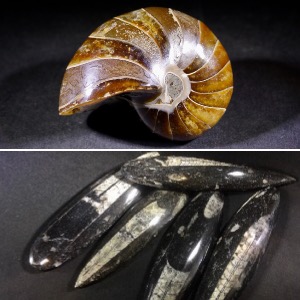 The Molluscs compose the large group of invertebrate animals known as the Mollusca. Around 85,000 extents species of Molluscs are recognised. The Molluscs compose the large group of invertebrate animals known as the Mollusca. Around 85,000 extents species of Molluscs are recognised.
Molluscs not just in size and in anatomical structure, but also in behaviour and in habitat too are a very diverse group that includes Chitons, Scaphopods, Bivalves, Gastropods and Cephalopods. The soft body is rarely preserved, so Molluscs are classified by their shell structure.
Nautiloids:
Nautiloids are primitive, marine cephalopods that possess a shell. Straight (like an Orthoceras), curing, or loosely or light coiled calcium-carbonate shells, divided into a chambered phragmocone and a living chamber. The chambers are connected by a tube (siphuncle)
Nautiloids had heads with well-developed eyes, and gasping tentacles. They swam by squirting water out of the body cavity.
|
|
Plants and Trees |
 Selection of Selection of
Petrified / Fossil Wood
Fossilised Leaves
Fossilised Algae
|
|
Reptiles - Dinosaurs |
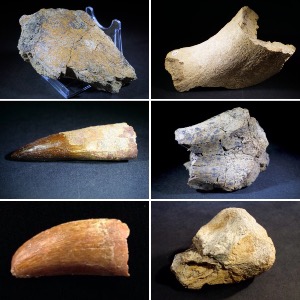 This successful Diapsid (Dinosaurs) group, made up mainly of land-dwelling reptiles, first appeared about 225 million years ago, having evolved from the closely related thecodontian archosaurs ( ancestors of the dinosaurs). They are divided into two orders: the reptile-hipped Saurischia, in which the pubic bone faces forwards; and the bird-hipped Ornithischa, in which it faces backwards. Included in the Saurischia are the great four-footed herbivores and the two-footed flesh-eaters, while the Ornithischia contains the remaining planet-eaters. The rise to dominance of the dinosaurs has been attributed to modifications of the limbs and girdle bones, which so improved their stance and gait that they were able to adapt to new habitats. Their largely unexplained extinction at the end of the Mesozoic Era, along with most of the great aquatic reptiles, brought to an end 150 million years of domination. This successful Diapsid (Dinosaurs) group, made up mainly of land-dwelling reptiles, first appeared about 225 million years ago, having evolved from the closely related thecodontian archosaurs ( ancestors of the dinosaurs). They are divided into two orders: the reptile-hipped Saurischia, in which the pubic bone faces forwards; and the bird-hipped Ornithischa, in which it faces backwards. Included in the Saurischia are the great four-footed herbivores and the two-footed flesh-eaters, while the Ornithischia contains the remaining planet-eaters. The rise to dominance of the dinosaurs has been attributed to modifications of the limbs and girdle bones, which so improved their stance and gait that they were able to adapt to new habitats. Their largely unexplained extinction at the end of the Mesozoic Era, along with most of the great aquatic reptiles, brought to an end 150 million years of domination.
|
|
Reptiles - Marine |
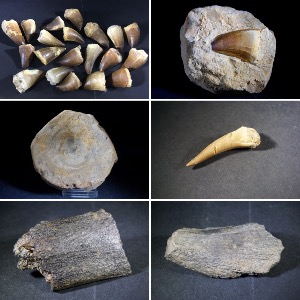
Marine reptiles are reptiles which have become secondarily adapted for an aquatic or semi-aquatic life in a marine environment.
The earliest marine reptiles arose in the Permian period during the Paleozoic era. During the Mesozoic era, many groups of reptiles became adapted to life in the seas, including such familiar clades as the Ichthyosaurs, Plesiosaurs, Mosasaurs, Nothosaurs, Placodonts, Sea Turtles, Thalattosaurs and Thalattosuchian.
After the mass extinction at the end of the Cretaceous period, marine reptiles were less numerous. Extant marine reptiles include Marine Iguanas, Sea Snakes, Sea Turtles and Saltwater Crocodiles.
Some marine reptiles, such as ichthyosaurs and mosasaurs, rarely ventured onto land and gave birth in the water. Others, such as sea turtles and saltwater crocodiles, return to shore to lay their eggs. Some marine reptiles also occasionally rest and bask on land.
|
|
Stromatolites |
|
Fossil Stromatolites are among the oldest evidence for life on Earth with some fossils dating back as far as 3.5 billion years old.
Stromatolites are layered sedimentary formations (microbialite) that are created mainly by photosynthetic microorganisms such as cyanobacteria, sulphate-cyanobacteria, sulphate-reducing bacteria, and Pseudomonadota. These microorganisms produce adhesive compounds that cement sand and other rocky materials to form mineral "microbial mats". In turn, these mats build up layer by layer, growing gradually over time.
|
|
Vertebrates - Fish |
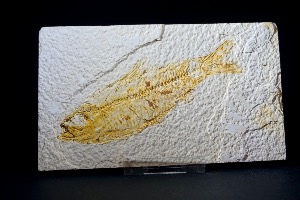
The earliest group of fish to be found as fossils are classified as agnathans. In Wyoming, USA, small pieces of bone from these fish are earliest vertebrate remains in rocks of Cambrian age. Agnathans are a group with jaws, and many had thin, heavily armoured bodies. The ostracoderms are the main fossil representatives within the agnathan class, which today contains the scale-less, eel-like lampreys (sometimes also called lamprey eels)
During the Late Silurian and Devonian periods fish evolved rapidly. With a number groups developed. The Placoderms, which are now extinct, had primitive jaws and paired fins. These fish were the most common vertebrates towards the end of the Devonian period. Other jawed fish include the Chondrichthyes. Some fish within this group have skeletons made of cartilage, and sharks such as Carcharodon are classified here. The final important group are the Osteichthyes. These are the bony fish common and wide-spread today, which first appear as fossils in the Devonian period. Within this group the teleosts are the most numerous, and the Crossopterygians have many similarities with Amphibians. |
|
Vertebrates - Mammals |
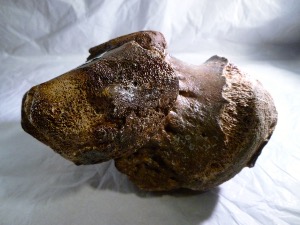 Mammals are a very successful group. From Terrestrial origins they have colonised most of the habitable are of the Earth’s surface, oceans and the air. The main identifying features of mammals, such as the possession of hair, milk-producing mammary glads, and the details of their reproductive system, are rarely preserved as fossils. To palaeontologist, the most vital mammalian identification feature is the jaw articulation between the dentary bone (the only bone in the lower jaw) and the squamosal bone in the skull. The quadrate and articular bones, forming the articulation in other vertebrates, became associated with mammalian hearing, and survived today as the incus and malleus of the middle ear. Mammals are a very successful group. From Terrestrial origins they have colonised most of the habitable are of the Earth’s surface, oceans and the air. The main identifying features of mammals, such as the possession of hair, milk-producing mammary glads, and the details of their reproductive system, are rarely preserved as fossils. To palaeontologist, the most vital mammalian identification feature is the jaw articulation between the dentary bone (the only bone in the lower jaw) and the squamosal bone in the skull. The quadrate and articular bones, forming the articulation in other vertebrates, became associated with mammalian hearing, and survived today as the incus and malleus of the middle ear. |
|



